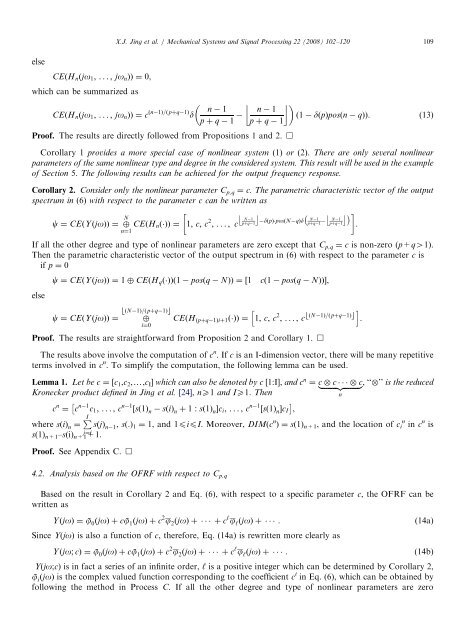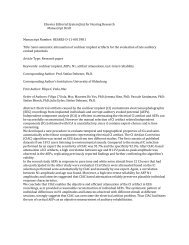Output frequency response function-based analysis for nonlinear ...
Output frequency response function-based analysis for nonlinear ...
Output frequency response function-based analysis for nonlinear ...
Create successful ePaper yourself
Turn your PDF publications into a flip-book with our unique Google optimized e-Paper software.
else<br />
CEðHnðjo1; ...; jonÞÞ ¼ 0,<br />
which can be summarized as<br />
CEðHnðjo1; ...; jonÞÞ ¼ c<br />
ðn1Þ= pþq 1 ð Þ d<br />
n 1<br />
p þ q 1<br />
n 1<br />
p þ q 1<br />
Proof. The results are directly followed from Propositions 1 and 2. &<br />
ð1dðpÞposðn qÞÞ.<br />
(13)<br />
Corollary 1 provides a more special case of <strong>nonlinear</strong> system (1) or (2). There are only several <strong>nonlinear</strong><br />
parameters of the same <strong>nonlinear</strong> type and degree in the considered system. This result will be used in the example<br />
of Section 5. The following results can be achieved <strong>for</strong> the output <strong>frequency</strong> <strong>response</strong>.<br />
Corollary 2. Consider only the <strong>nonlinear</strong> parameter Cp,q ¼ c. The parametric characteristic vector of the output<br />
spectrum in (6) with respect to the parameter c can be written as<br />
N<br />
N 1<br />
pþq 1 dðpÞ posðN qÞd<br />
N 1<br />
pþq 1<br />
N 1<br />
pþq 1 .<br />
c ¼ CEðYðjoÞÞ ¼ CEðHnð ÞÞ ¼<br />
n¼1<br />
1; c; c 2 ; ...; c<br />
If all the other degree and type of <strong>nonlinear</strong> parameters are zero except that Cp,q ¼ c is non-zero (p+q41).<br />
Then the parametric characteristic vector of the output spectrum in (6) with respect to the parameter c is<br />
if p ¼ 0<br />
c ¼ CEðYðjoÞÞ ¼ 1 CEðHqð ÞÞð1 posðq NÞÞ ¼ ½1cð1posðq NÞÞŠ,<br />
else<br />
bðN c ¼ CEðYðjoÞÞ ¼<br />
1Þ=<br />
ðpþq1Þc CEðHðpþq 1Þiþ1ð ÞÞ ¼ 1; c; c 2 h<br />
ðN ; ...; cb 1Þ=<br />
ðpþq i<br />
1Þc<br />
.<br />
i¼0<br />
Proof. The results are straight<strong>for</strong>ward from Proposition 2 and Corollary 1. &<br />
The results above involve the computation of c n .Ifc is an I-dimension vector, there will be many repetitive<br />
terms involved in c n . To simplify the computation, the following lemma can be used.<br />
Lemma 1. Let be c ¼ [c1,c2,y,cI] which can also be denoted by c [1:I], and cn ¼ c<br />
Kronecker product defined in Jing et al. [24], nX1 and IX1. Then<br />
c c,‘‘<br />
’’ is the reduced<br />
|fflfflfflfflfflfflfflffl{zfflfflfflfflfflfflfflffl}<br />
n<br />
c n ¼ c n 1 c1; ...; c n 1 ½sð1Þn sðiÞn þ 1 : sð1ÞnŠci; ...; c n 1 ½sð1ÞnŠcI ,<br />
where sðiÞn ¼ PI<br />
sðjÞn 1, s(.) 1 ¼ 1, and 1pipI. Moreover, DIM(c<br />
j¼i<br />
n n n<br />
) ¼ s(1) n+1, and the location of ci in c is<br />
s(1)n+1–s(i)n+1+1.<br />
Proof. See Appendix C. &<br />
4.2. Analysis <strong>based</strong> on the OFRF with respect to Cp,q<br />
ARTICLE IN PRESS<br />
X.J. Jing et al. / Mechanical Systems and Signal Processing 22 (2008) 102–120 109<br />
Based on the result in Corollary 2 and Eq. (6), with respect to a specific parameter c, the OFRF can be<br />
written as<br />
YðjoÞ ¼ ¯j 0ðjoÞþc ¯j 1ðjoÞþc 2 j2ðjoÞþ þc ‘ j ‘ðjoÞþ . (14a)<br />
Since Y(jo) is also a <strong>function</strong> of c, there<strong>for</strong>e, Eq. (14a) is rewritten more clearly as<br />
Yðjo; cÞ ¼ ¯j 0ðjoÞþc ¯j 1ðjoÞþc 2 j2ðjoÞþ þc ‘ j ‘ðjoÞþ . (14b)<br />
Y(jo;c) is in fact a series of an infinite order, ‘ is a positive integer which can be determined by Corollary 2,<br />
¯j iðjoÞ is the complex valued <strong>function</strong> corresponding to the coefficient c i in Eq. (6), which can be obtained by<br />
following the method in Process C. If all the other degree and type of <strong>nonlinear</strong> parameters are zero

















